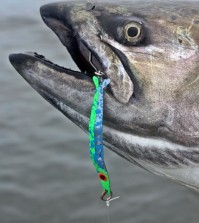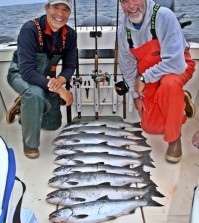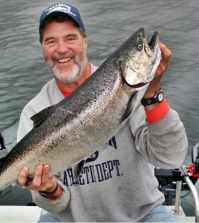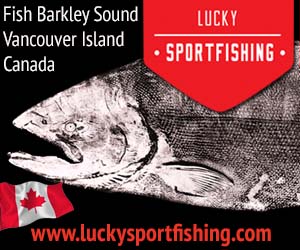Chasing the Birds
Waking up at 4 a.m. to the sounds of pounding rain, creaking docks and small boats banging together, my fishing partner and I talked briefly about going back to bed, but this would be our last full day of fishing the salmon-choked waters around British Columbia’s Langara Island, and the chinook fishing had been so good the first two days that we couldn’t stand the idea of “the fleet” hitting the water while we slept in. A few minutes later we were in the galley of the Charlotte Princess, being told that a 25-knot southerly was going to prevent us from fishing all the spots along the east side of the island where we had been catching kings, as well as the west side, where we had hoped to fish on day three.
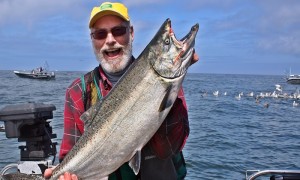
David Mudd trolled past feeding birds to take this nice Westport chinook. Note the birds to his right and another angler hooking in the background to his left. (Terry Rudnick photo)
So, after trying to fish a couple of other spots in three- to four-foot seas, we joined the anglers in about 30 other boats from three different fish camps that were trolling back-and-forth along the shoreline of Graham Island, only 10 minutes from our floating lodge. Four or five half-ton sea lions had also laid claim to the fishing grounds, and they were enjoying much better “fishing” than anyone else. But every now and then someone managed to net a decent chinook—and, this was pretty much the only game in town—so we trolled back-and-forth, back-and-forth, back-and-forth with everyone else.
After maybe an hour and a half of fruitless trolling, my partner put a chrome 10-pound Coho in the boat, and our enthusiasm got a little boost. We both re-baited and starting out again, and quickly realized there were about a dozen birds working the surface 50 yards in front of us. There were other boats closer to the little feeding frenzy, but none seemed to pay any attention, so I sped up and trolled right through what turned out to be a big ball of one-inch baitfish, herring as near as I could tell.
As we passed over the bait ball and I was in the middle of saying, “Well, it was worth a try,” the tip of my 10 ½-foot Canadian mooching rod dipped into the water and my Shimano knuckle-buster started to chatter. For a couple of seconds I assumed it was another nice Coho, but then line started peeling off the reel in what turned out to be about a 75-yard run, and there was little doubt that I was hooked up to something with a purple hue to it. We somehow averted disaster when the big king dashed under the hull of a boat that was trolling downrigger gear, and 15 minutes after I hooked up my partner slid the net under a plump chinook that later tipped the scales to an even 31 pounds, our only king that day and the biggest of the trip.
Had we ignored that little flock of birds, as everyone else did that wet, windy morning, it would have turned out to be just another semi-miserable day on the water.
Before the preceding anecdote leads anyone to the assumption that I’m a confirmed bird-chaser whenever I’m out on the salmon grounds, it ain’t necessarily so. Unlike a few of my fishing buddies who crank in their gear and take off like their hair’s on fire to run a quarter-mile anytime they spot two or more birds hovering over the water, I’m a little less likely to assume that wherever there are birds there are always hungry salmon. And, even if I spot actively feeding birds in the distance, if I’m having any kind of success where I am, I’ll stay there. I’m a firm believer in the 10 Commandments of Salmon Fishing, one of which—I think it’s number 2 or 3—says “Never leave fish to search for fish (even if you spot a big flock of birds feeding on the surface).”
In fact, on more than one occasion I’ve spent hours trolling over, under, around and through hundreds of actively feeding seabirds without drawing so much as a single hook-up, only to have a great salmon bite turn on half an hour after the birds dispersed and disappeared.
On the other hand—and getting to the point of this little story—there are definitely times when feeding birds are the rainbow and hungry Coho or chinook are the piscatorial pot of gold at the end. A variety of aquatic birds, from gulls, terns, cormorants and pelicans to murres, auklets and shearwaters, feed on the same baitfish, krill and other organisms that salmon feed on, so where there are birds in and above the water, there may well be salmon below. And it’s not just that the bait happens to be there between fish and fowl; it’s usually trapped between the two, with the birds keeping bait pinned down and the salmon cutting off their escape from below.
Using the birds to help find and catch salmon is all about finding birds that are actively feeding, not just spotting stuff flying around out there. Yes, if large numbers of birds, especially a variety of species, all seem to be heading toward the same place, it might be worthwhile keeping an eye on them, but unless you can determine that they’re all piling into one spot, they’re probably not helping you much.
If you can see where they’re landing, though, and they’re crashing into the water, splashing, screaming and squawking, and coming up with lots of little shiny, wiggly things in their beaks, you’d be wise to investigate. Those are the actively feeding birds you’re looking for. The only thing on their little bird minds is eating, and they’re not particularly subtle or quiet about it, so if you can’t tell what they’re up to, it’s your fault.
In fact, with some species it’s almost impossible not to notice. When a dozen pelicans start laying their wings back against their bodies and dropping out of the sky like frozen turkeys thrown from the roof of a four-story building, it catches your attention, and you know there’s something under the surface that makes it worth their while. Some other larger birds, such as herring gulls and cormorants, don’t put on such a spectacular show, but when they converge in large numbers they’re pretty easy to see and, in the case of gulls, to hear from some distance away.
Speaking of large numbers, anyone who has spent much time fishing the coast has probably encountered a teal-size, grey-brown bird cruising along a foot or two off the water. Except, it’s never just one grey-brown bird, it’s more likely to be several hundred or more of them. They’re called sooty shearwaters, and they’re the most numerous summertime visitor to our coastal waters. They like hanging out with their own kind, and they really seem to like eating together, so when a hundred or so of them find a school of anchovies, squid or other tasty morsels, some sort of telepathic communication occurs, and sooty shearwaters come swarming in like locusts, oftentimes by the thousands. As you might guess, it takes a lot of protein to hood the attention of several thousand hungry shearwaters, and where you find that much bait, you’re very likely to find at least a few hungry salmon.
Other birds, though, aren’t so communal or so obvious in their dining habits. The Bonaparte’s gull is kind of a loner, seldom found feeding with other species or even with many of its own kind. But when you find a few of them dabbling along the water’s surface, usually around the entrances to estuaries, along current breaks or tide rips, it’s often a sign that they’re working on krill, and where there’s krill there are often salmon, especially Coho. It’s no coincidence that Bonaparte’s gulls are sometimes referred to as “Coho birds.”
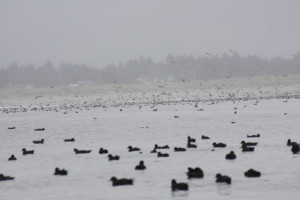
A couple hundred sooty shearwaters are just starting to work over a large school of baitfish along the Washington coast while those in the foreground either haven’t yet realized what’s going on behind them or are already full. (Terry Rudnick photo)
So, how should you go about approaching and fishing the site of an avian feeding frenzy of some kind? Although at the start of this story I described plowing right through one and coming up big, that’s oftentimes not the best strategy, because you’re likely to scatter the birds, which allows the bait to disperse and cause whatever salmon may be under them to disperse as well. Another downside of that approach is that some sea birds are capable of diving to depths of 100 feet or more, and when in all-out feeding mode are just as likely to take your bait or lure as a salmon is. Playing and dealing with an angry bird sporting a very sharp beak can take up a lot of fishing time and result in some damn nasty holes in your hands, arms and other body parts.
A better strategy usually is to work the edges of the action, staying as close as you can without disrupting it. Keep in mind that salmon are likely to be working the bait from under and around the sides, and your spoon, hoochie or fresh herring will be much more readily visible in open water a few feet from the bait ball than it might be when surrounded by millions of other juicy little morsels. For that reason, be especially alert for strikes as you approach feeding birds and as you drift or troll away from them.
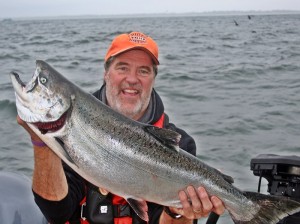
The author was approaching a large flock of feeding birds when he hooked up on this Westport king, his last saltwater chinook of the 2015 season. (Bob Gibbons photo)
The strategy of “matching the hatch” by replicating the size, color and/or shape of whatever you think the salmon are eating often pays good dividends, I’m not sure it’s of any benefit when fishing among and around a bird frenzy. Chances are good that whatever the birds are feeding on are all the same—a school of two-inch anchovies, four-inch herring, small squid, krill or whatever—and a bait or lure that’s the same size and color of all those other baits may get lost in the shuffle, while something that’s much bigger, a totally different color or moving much slower may stand out or appear to be an easier target.
As for how deep you might want to fish, if I can determine where the “bottom” of the bait mass seems to be, I like to troll, jig or mooch at that depth, assuming that salmon are likely to be attacking the bait from beneath, and want my offering to be down there where they are. If, on the other hand, my depth sounder/fish finder tells me there are salmon higher up in the water column, working the sides of the bait mass, I crank up to or just above where I’m seeing the marks.




